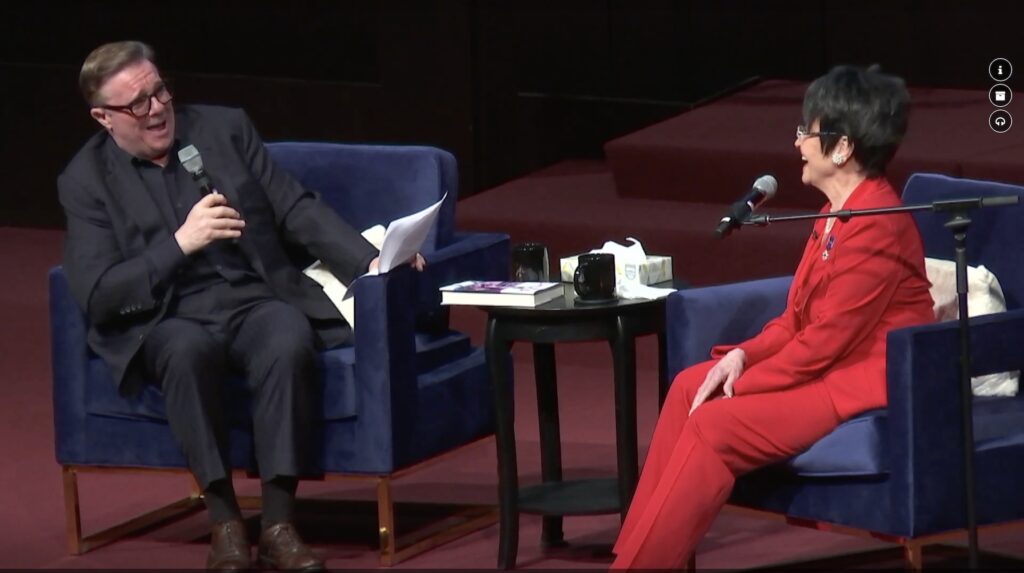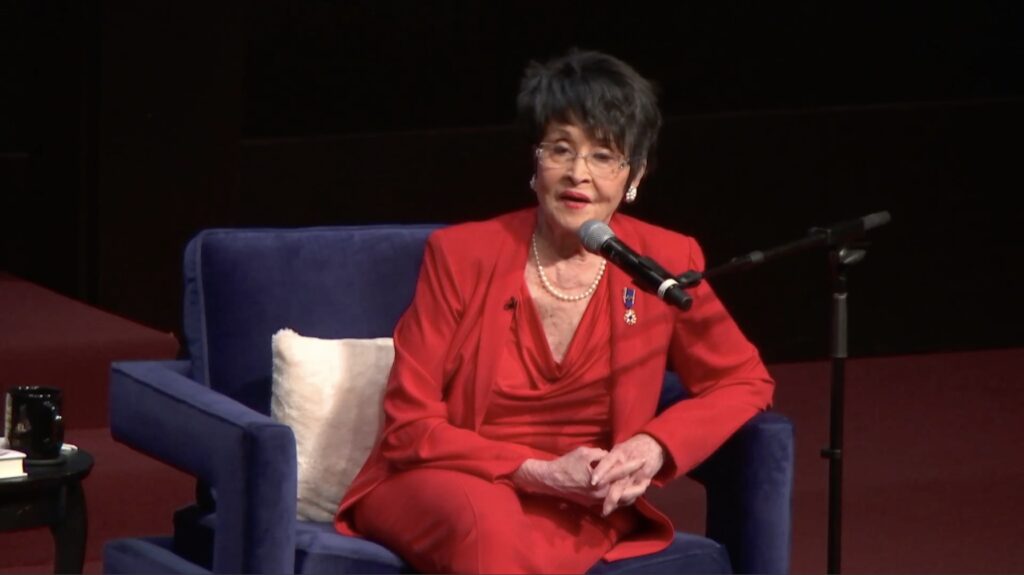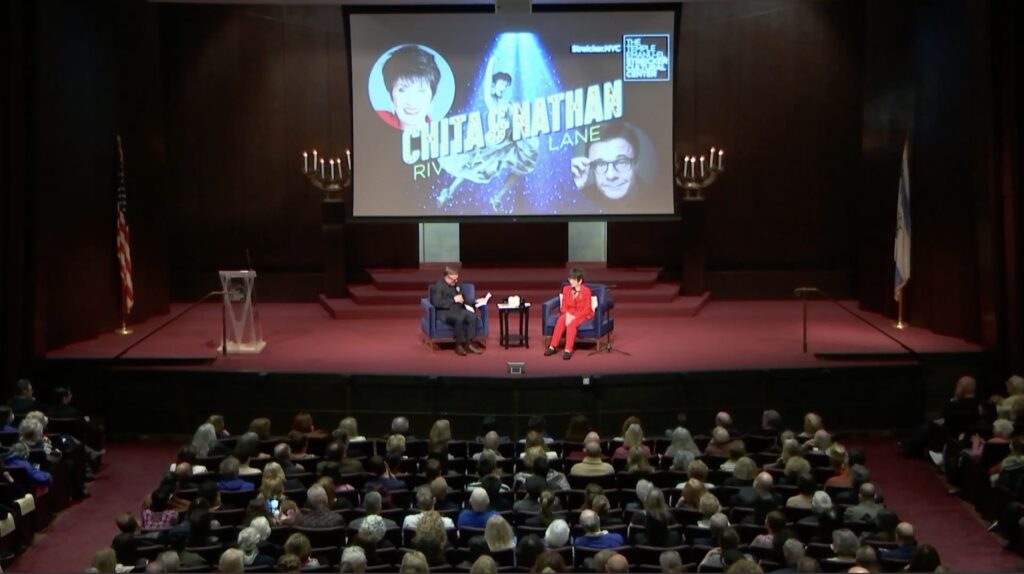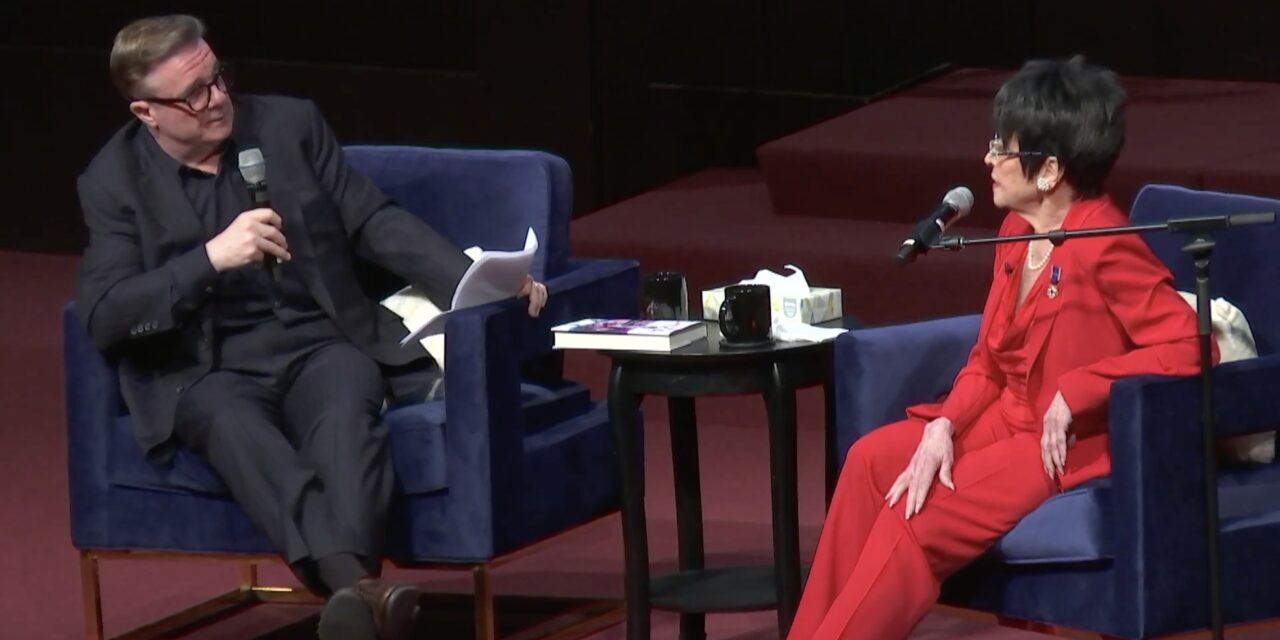By Matt Smith . . .
Living legend, multi-award winner and newly-minted memoirist Chita Rivera popped into the Temple Emanu-El Streicker Cultural Center on Monday night, her first of many stops on a rousing book tour celebrating both her treasured tome and her feted career, to chat with Tony winner Nathan Lane about the hoops, the hurdles, and the unending happiness that awaits one on the other side of a singular, nine-decade journey through life.
Unveiling tales from her time spent in iconic shows like Kiss of the Spider Woman, Chicago, and West Side Story, with passes at primates, parenting and Paul Lynde, here are some of our favorite snippets she shared at the talkback, all of which are, luckily for us, discussed at greater length within the book.
Happy reading . . . and all that jazz!!

A (happy?) accident at home led her to the New York ballet.
“I always had this active imagination and [dynamic] energy,” she says, detailing her “tomboy” indulgences of roller-skating, bicycling and climbing the neighborhood fences. “I was so rambunctious that I used to jump from furniture [piece] to furniture [piece] . . . from sofa to chair across the coffee table and back again.”
Her mother constantly warned her to be careful, but being a boisterous kid, Rivera paid her no mind. “One day, while jumping, I missed.” She hit the glass coffee table head-on and it broke. “I’m standing there in the coffee table . . . and my mother said, ‘That’s it, you’re out of here, you’re going to a ballet school.’” And a legend was about to be born.
Though she made sure they never deterred her, she faced hardships early on.
Years of rigorous, regimented training from Ms. Doris Jones—a “second mother . . . who channeled my crazy energy and taught me discipline and to care about the ballet”—eventually caught the attention of George Balanchine’s School of American Ballet. “They sent some representatives out from the school,” Rivera says. “I was among the students sent to audition for Balanchine” in hopes of gaining a New York City Ballet scholarship.
“I got off the elevator and there were all these girls . . . very tall, blonde, skinny dancers.” One of them, anxious and tense, ran out of the room, shouting, “I can’t do this! I’m just too nervous!”



Rivera—while acknowledging she was short and Puerto Rican—approached Ms. Jones to see if she could, in a way, fill in for the frightened girl. (“What is it she can’t do? Maybe I can do that!”) And Ms. Jones turned and said to her, “You just stay in your own lane. Take care of your own business, and just do what I’ve taught you to do.” However honest the statement was, given that Rivera was so young and green, it stung . . . not least because it was not the only time she would hear a comment like that.
Subsequently, while performing in Meredith Willson’s musical, 1491, the composer asked her why she didn’t have a Spanish accent. “Why should I have an accent?” Rivera rebuffed. “Because my name is Conchita Figueroa del Rivero?! What is that?!”
Another prominent example occurred earlier, during her audition for Can-Can in the 1950s. “There were 200 people at this [audition] and they only needed one,” she says. Rivera ultimately found herself in a final callback opposite just one other person . . . and she didn’t get it.


Choreographer Michael Kidd came out to see her in the lobby after the audition and apologized, saying, “he preferred me dance-wise [to the other girl] . . . but that I wouldn’t fit into the wigs and costumes.” (The chosen’s hair was a different color, so they could adjust the wig to match her).
Fortunately, Kidd not only used Rivera in Guys and Dolls, replacing departing dancer Onna White, but eventually cast her In both the Broadway company and the tour of Can-Can later on. Still, Rivera maintains that the initial moment stung . . . and she’s, obviously, never forgotten it.
She met George Balanchine in an unconventional way.
“There was a wonderful, older gentleman sitting in the back” at her NYC ballet tryout, during which Rivera explains she developed a blister on her heel.
“All of a sudden, I look down and see red on my pink tights.” The gentleman was quick to notice it, too. “He stopped the audition and made me put my foot on his lap,” Rivera explains. “He [then] took off my shoe, and told somebody to go out and get scissors,” so the fabric could be cut off.
“And he bandaged you . . . ” Lane piped in, finishing the sentence.
“He did, and I got back on pointe again, finished the audition, and . . . won the scholarship to this ballet school.”
It was only after the audition that Rivera discovered this kindly, “most gentle grandfather” of a man was none other than George Balanchine himself. They say everything happens for a reason . . .


She found her way to Broadway through happenstance.
Rivera’s friend Helen (no last name given)—who did not receive a scholarship to New York City Ballet—was able to secure an audition for a Broadway show in New York. Terrified, she urged Rivera to accompany, and audition alongside her, and Rivera complied.
“I was never afraid,” Rivera says, reminding us of her spunky, outgoing attitude as a tyke. “I went right down front with no fear at all and danced my heart out.”
“Helen was in the back,” Rivera goes on. “She didn’t get the job.” But Rivera did . . . and—proudly, she says—“I’ve never looked back.”
She has a feisty alter ego named Dolores.
Dubbed as such after her given first name (she was born Dolores Conchita Figueroa del Rivero—”and there’s actually more to that name, but we just say [that much]!”), the irreverent doppelganger makes an appearance when the demure Chita needs a confidence boost. “She’s responsible for everything,” Rivera admits, saying she gave her grit, power, agency, and “the fight” to soldier on. “She saved my life, really.” (Plus, Rivera adds, with a laugh “She’s great company.”)
One of the best examples of Dolores going “full Puerto Rican,” in the words of her daughter, Lisa Mordente, came when Bye Bye Birdie co-star Paul Lynde snubbed her then-husband, Tony, also an actor in the show, after a performance.
Returning to the Strouse-Adams tuner after having been away shooting the film version (in which he appeared as a different character), Tony became flustered one night and flubbed a line, in turn, catching Lynde off-guard. “Paul was so rude and so mean to Tony,” Rivera recalls—and as a result, Dolores went to work.
“After the show, I went upstairs, knocked on the door, stuck one foot in [to pry it open], and I said: ‘Don’t you ever talk to anybody in this company like that ever again. Do you hear me?’ He backed up into the wall and I turned around and walked out. Just like that.”
Lynde later apologized, and, of course, Rivera forgave him, but Dolores never forgot.


She knew that with West Side Story, she was part of something special.
“That was the beginning of a big change in my life,” she says. “To be in a room with a young Stephen Sondheim, Arthur Laurents, Leonard Bernstein, Jerry Robbins . . . and to be given [a platform] to tell the story of what was going on in our neighborhoods at the time [under the auspicies] of a great Shakespearean masterpiece?! What was there to deny?!”
On that note, she wasn’t bothered by Rita Moreno’s casting over her in the West Side Story film, but the use of the dress unnerved her.
“I wasn’t upset [to lose out on the role] because, thank God, I was doing Birdie at the time, and [being in the film] would mean I would not have had that experience . . . ” which, she says, was a success, to boot.
But the iconic purple dress—custom-developed because Rivera loved purple—and its unique single earring accessory popped up as well . . . and Chita wasn’t having it.
“That bothered me more than anything,” she says, of the item she felt she made famous in the first place. “I watched it and I thought . . . ‘dang it, she’s got my dress on. And—gasp—there’s my earring!’”
In short, the role might not have been exclusively hers, but, in her eyes, that dress undoubtedly was.


Speaking of the dress, she believes it had a power all its own.
Jerome Robbins was in a rehearsal with Debbie Allen for the 1980 West Side Story revival. “He couldn’t remember a few steps he was looking for,” Rivera explains. “He called me to come in . . . and I couldn’t remember, either.” She asked if she could sleep on it, and Rivera went home to decipher the routine. “I had the [rehearsal] petticoat [version] of the original purple dress,” she describes. “And I took out the petticoat . . . and I put it on . . . and gosh darn it, that petticoat knew the steps.”
Dubbing costumes and choreography as “musical dialogue,” Rivera asserts that the clothes one wears in a production are as important as what one says . . . and this iconic example is proof.
People wanted her and Gwen Verdon to fight in Chicago.
Looks like our obsession with celebrity feuds was just as rampant in 1975! “They wanted so badly for us to have some turmoil,” she explains, pointedly adding, “We didn’t, of course.”
When pushed by Lane to answer as to why, Rivera responded, bluntly, “Because it was [a show] with two women. How ridiculous!”
Originally, Rosie Alvarez in Bye Bye Birdie was intended to be Polish.
“I guess the Spanish Rose number would have been the Polish Kielbasa number,” Lane jokes. “They’re lucky you came along.”
“I learned from Dick [Van Dyke] later on, that the role was offered to Carol Haney,” Rivera details, “[who], for some reason, wasn’t able to do it . . . don’t ask me why.” The role then went to Chita.
Upon Rivera’s casting, the character changed to be of Latin descent, with the signature number becoming the now-famous “Spanish Rose.” “It worked out,” the dancer says, with a smile. “I really scored with that number.”



She obtained Spider Woman partly at critic Frank Rich’s suggestion.
While reviewing a workshop production of the show, then starring Donna Murphy, Rich inquired in his review, “Why didn’t they get Chita for the role of the Spider-Woman?” “I really, really never thought about it,” Rivera confesses, “because I assumed that they had thought about it and thought I was wrong [for the role].” But upon reading Rich’s commentary, Rivera recalls, “they suddenly thought, Why not?” Two years later, when a revamped production opened in Toronto (and subsequently transferred to London and then, finally, Broadway), Rivera was cast. A second Tony Award followed, and history was established once again.
She didn’t care about star treatment.
As she writes in the book, Fred Ebb told her, “You have to learn to act like a star. If you act like a star, they’ll treat you like a star.” “But I didn’t care!” she professes. “I was working. I was a working actor and [doing] what I wanted to do. More than anything else, I just wanted to put my passion in my work, and tell the stories, and I was glad that I was able to. To me, that’s all that mattered.”
She also didn’t initially consider herself a singer.
It almost even deterred her from auditioning for West Side Story. “At the time [that I was starting out], the dancers danced and the singers sang,” she says. “And I was a dancer. It was as simple as that.”
Given her subsequent success and lengthy Broadway résumé, Lane assures her: “The only thing that is wrong in this book is that you say you didn’t consider yourself a singer. You have one of the greatest voices that has ever been heard in the American theater. You can belt, you can sing quietly . . . whatever you do, it’s just beautiful. Believe that.”
She has a special place in her heart for her friend, the late Terrence McNally.
“He made me speak words that I would have spoken had I thought of [them]. He gave me my stage language . . . Truly. All I had to do was say the words exactly the way it was written . . . as he meant them . . . and it was smooth sailing from there.”
Her favorite holiday is Halloween.
“My house is decorated on Halloween like [the way others are for] Christmas. I’ve got caskets and all sorts of decorations. It’s frightening but delicious!” (“So you’re really a gay at heart,” Lane quips).
She’s a fan of sumo wrestling, and she adores gorillas.
“I would give anything to have a gorilla come out here right now and see what you would do,” she tells the audience. “But they’re really the most gorgeous, gentle creatures. They thrill me and I love them very much.”
She wrote the book because she felt she—finally—had something to say.
“It was time,” she says, in response to the question “Why now?” “It was just time.”
“And partnering with [co-author] Patrick Pacheco was easy. When you’re close friends with someone like we are, it’s easy—or easier—to open up. [With friends], even when you’re joking you’re still telling the truth.”
“I am so grateful for the life that I have been given, and [through writing] was able to acknowledge the time and the opportunities that I had,” including two Tony Awards, several Drama Desk Awards, a meeting with the Pope, and, above all, being the first Latina to receive a Kennedy Center Honor.
“And this is the Presidential Medal [of Freedom],” she says, brandishing the esteemed honor she received from President Obama in 2009.
“I’m happy with where I am,” she concludes. “And I can’t [believe] all I’ve done, so I decided that it was time I should share it.”
She’s learned how to hold her own, and she’s passing on advice as to how she did it.
“You can’t have anything unless you understand yourself,” she responds, when asked what advice she would bestow upon aspiring triple-threats and young people today.
“You must be passionate about your work, and go toward whatever you’re doing with [vigor]. You’ve got to be ready, you must work really hard and you must try not to look behind you too much. Be in the moment and look forward to the next day . . . and don’t be afraid to show what you’ve got.”
“I never dreamed that I’d be sitting with you”—she says, gesturing toward Lane—“talking about my memoir, for goodness sake.”
“Just be open and honest . . . with others and with yourself. I don’t know that there’s anything more to it than that,” she concludes. ”But if you’re patient enough and if you’re lucky enough, it’ll work out for you.” Just as it did for her.
Chita Rivera appeared in conversation with Nathan Lane at the Temple Emanu-El Streicker Cultural Center (1 E. 65th Street) on April 24. For more information on her tour, which continues through May 15, click here. Chita: A Memoir, co-authored with journalist Patrick Pacheco, is available now wherever books are sold.


















